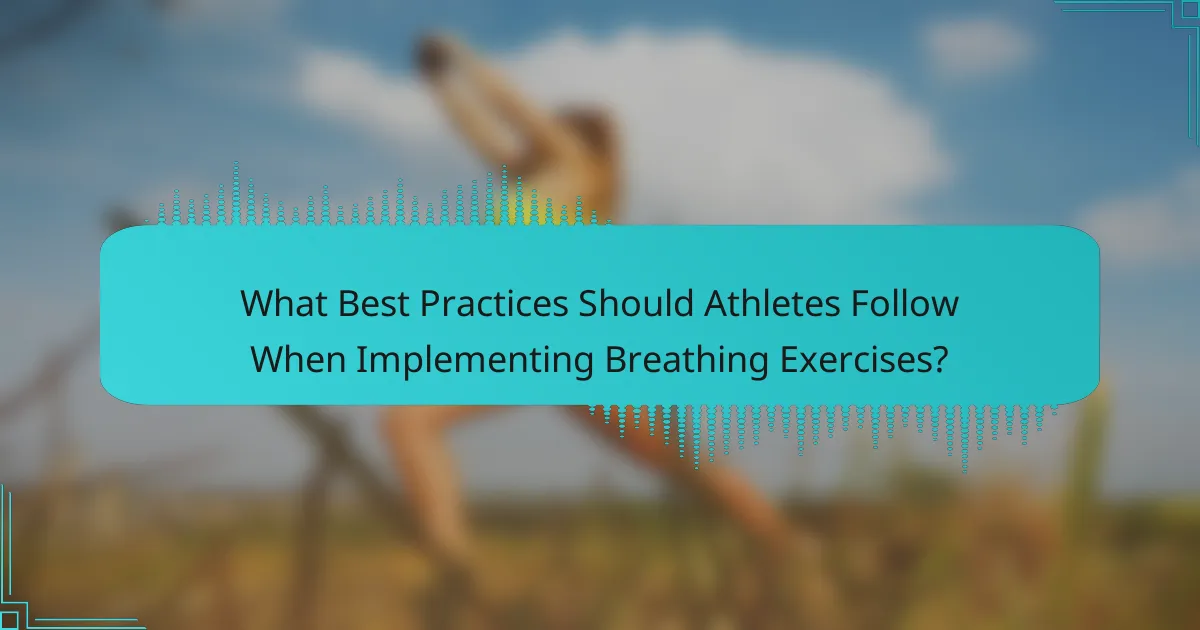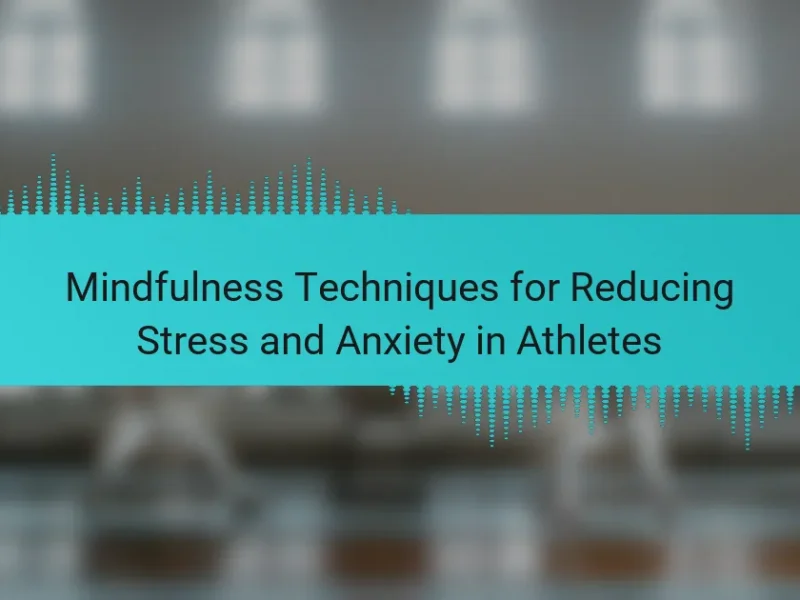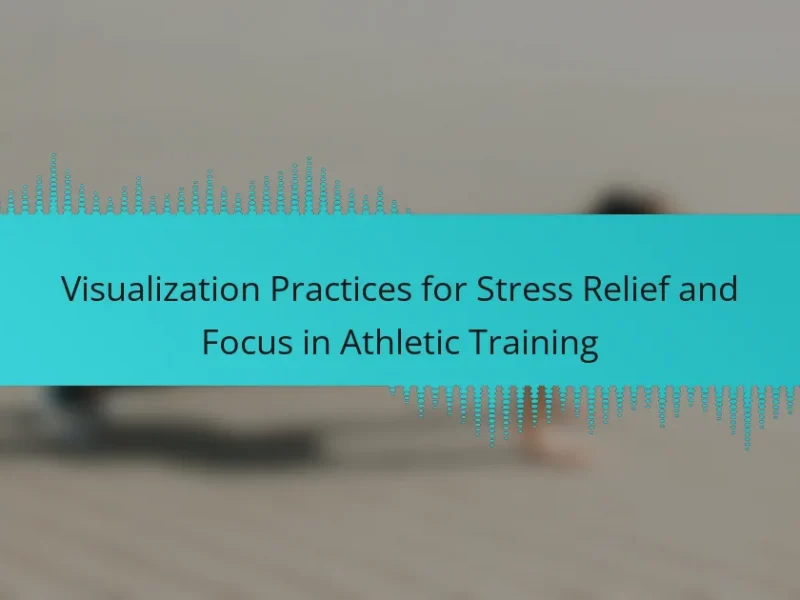Managing performance anxiety is crucial for athletes aiming to achieve their best. Breathing exercises like diaphragmatic breathing and box breathing promote relaxation and focus. These techniques lower cortisol levels and enhance mental clarity. Regular practice can improve lung capacity, recovery times, and overall athletic performance.

What are Breathing Exercises for Managing Performance Anxiety in Sports?
Breathing exercises effectively reduce performance anxiety in sports by promoting relaxation and focus. Techniques such as diaphragmatic breathing, box breathing, and 4-7-8 breathing help athletes manage stress and enhance concentration. Diaphragmatic breathing encourages deeper inhalation, increasing oxygen flow and reducing tension. Box breathing involves equal inhalation, retention, exhalation, and retention, creating a calming rhythm. The 4-7-8 method, emphasizing a longer exhale, activates the parasympathetic nervous system, fostering tranquility. Regular practice of these techniques can significantly improve athletic performance by minimizing anxiety and boosting confidence.
How do Breathing Exercises Help Athletes Cope with Anxiety?
Breathing exercises significantly help athletes manage performance anxiety by promoting relaxation and focus. These techniques reduce stress hormones and increase oxygen flow, enhancing mental clarity. Research shows that controlled breathing can lower heart rates and improve overall performance under pressure. Athletes often report feeling more centered and confident after practicing these exercises, which can lead to better outcomes in competitive situations.
What are the Common Types of Breathing Exercises Used in Sports?
Breathing exercises commonly used in sports include diaphragmatic breathing, box breathing, and pursed lip breathing. These techniques help athletes manage performance anxiety effectively.
Diaphragmatic breathing enhances oxygen intake and promotes relaxation. Box breathing, which involves inhaling, holding, exhaling, and pausing for equal counts, helps regulate stress levels. Pursed lip breathing slows down the breathing rate, aiding in better control during high-pressure situations.
Incorporating these exercises into training routines can significantly improve focus and composure under stress.
What is Diaphragmatic Breathing?
Diaphragmatic breathing is a technique that enhances oxygen intake and promotes relaxation, crucial for managing performance anxiety in sports. This method engages the diaphragm, allowing for deeper breaths, which can lower heart rate and reduce stress. Practicing diaphragmatic breathing can lead to improved focus and overall performance under pressure.
How Does Box Breathing Work?
Box breathing helps manage performance anxiety by promoting relaxation and focus. This technique involves inhaling for four counts, holding for four counts, exhaling for four counts, and holding again for four counts. As a result, it reduces stress hormones and increases oxygen flow. Athletes often use box breathing to enhance concentration and calm nerves before competitions. Research shows that controlled breathing can lower heart rates and improve mental clarity.
What is 4-7-8 Breathing Technique?
The 4-7-8 breathing technique is a structured method to promote relaxation and reduce performance anxiety in sports. It involves inhaling for four seconds, holding the breath for seven seconds, and exhaling for eight seconds. This technique activates the parasympathetic nervous system, which helps calm the mind and body. Regular practice can enhance focus and improve overall performance under pressure.

What Universal Benefits Do Breathing Exercises Offer Athletes?
Breathing exercises significantly enhance athletes’ performance by reducing anxiety and improving focus. These techniques help regulate heart rate and oxygen intake, fostering a calm state conducive to optimal performance.
Research indicates that controlled breathing lowers cortisol levels, which can mitigate stress and anxiety during competitions. Athletes employing these exercises report increased confidence and mental clarity, leading to improved decision-making on the field.
Incorporating breathing exercises into training routines offers unique benefits such as enhanced lung capacity and endurance. Techniques like diaphragmatic breathing and box breathing can be tailored to individual needs, making them versatile tools for athletes across various sports.
Regular practice of these exercises can also lead to rare attributes like improved recovery times and better sleep quality, further contributing to overall athletic performance.
How Can Breathing Exercises Improve Focus During Competition?
Breathing exercises can significantly enhance focus during competition by reducing performance anxiety. These techniques promote relaxation, enabling athletes to concentrate better on their tasks. Controlled breathing lowers heart rate and stabilizes emotions, allowing for improved decision-making and execution. Research indicates that athletes who practice breathing exercises experience heightened awareness and mental clarity, leading to superior performance under pressure.
What Role Do Breathing Exercises Play in Reducing Physiological Symptoms of Anxiety?
Breathing exercises significantly reduce physiological symptoms of anxiety by promoting relaxation and lowering heart rate. These exercises activate the parasympathetic nervous system, counteracting the stress response. Research indicates that controlled breathing can decrease cortisol levels, enhancing mental clarity and focus in sports. Athletes often use techniques like diaphragmatic breathing to manage performance anxiety, improving overall performance under pressure. Regular practice can lead to lasting benefits, making breathing exercises a valuable tool for anxiety management in sports.

What Unique Attributes Set Certain Breathing Techniques Apart?
Certain breathing techniques stand out due to their unique attributes, enhancing their effectiveness in managing performance anxiety in sports. Techniques like diaphragmatic breathing promote deeper oxygen intake, while box breathing establishes a structured rhythm that calms the mind. Additionally, the use of visualization in conjunction with breathing can create a mental anchor, helping athletes focus. These distinctive features contribute to the overall efficacy of breathing exercises, making them valuable tools for athletes facing anxiety.
How Does the Individual’s Sport Influence the Choice of Breathing Exercise?
The individual’s sport significantly influences the choice of breathing exercise to manage performance anxiety. Different sports require varying physical demands and mental focus, which dictate the effectiveness of specific breathing techniques.
For example, endurance sports like running benefit from diaphragmatic breathing to enhance oxygen intake and stamina. In contrast, sports requiring precision, such as archery or shooting, may utilize slow, controlled breathing to improve concentration and reduce anxiety.
Additionally, team sports often incorporate synchronized breathing exercises to foster group cohesion and collective calmness. Individual sports may focus more on personal breathing techniques tailored to the athlete’s unique psychological needs.
Ultimately, selecting the right breathing exercise depends on the sport’s unique attributes and the athlete’s specific performance goals.
What Personalization Strategies Enhance the Effectiveness of Breathing Exercises?
Personalization strategies enhance breathing exercises for performance anxiety by tailoring techniques to individual needs. Customizing breath patterns, duration, and visualization methods increases effectiveness. For example, athletes can adjust the intensity of inhalation and exhalation based on their anxiety levels. Incorporating personal triggers, such as specific sports imagery, can also improve focus and calmness. Additionally, monitoring progress through self-assessment tools helps refine techniques over time, ensuring they remain relevant to the athlete’s evolving performance context.

What Rare Attributes are Associated with Breathing Exercises in Sports?
Breathing exercises in sports can exhibit rare attributes such as enhanced proprioception, which increases body awareness during performance. They may also lead to unique physiological responses, like improved oxygen utilization efficiency. These rare benefits contribute to better focus and reduced muscle tension, ultimately aiding in managing performance anxiety.
What Are the Most Innovative Breathing Techniques Emerging in Sports Psychology?
Breathing exercises are increasingly recognized for managing performance anxiety in sports. Techniques like diaphragmatic breathing, box breathing, and 4-7-8 breathing are emerging as innovative methods. Diaphragmatic breathing enhances oxygen flow, promoting calmness. Box breathing, a structured pattern, helps athletes regain focus and control. The 4-7-8 technique, which emphasizes prolonged exhalation, reduces anxiety and improves concentration. These techniques are gaining traction due to their effectiveness in enhancing mental resilience and performance under pressure.
How Do Cultural Differences Affect the Adoption of Breathing Techniques?
Cultural differences significantly influence the adoption of breathing techniques for managing performance anxiety in sports. Variations in cultural attitudes towards mental health and physical training can affect how athletes perceive and implement these techniques.
For instance, in some cultures, mental wellness practices like breathing exercises are widely accepted and integrated into training regimens, enhancing athletes’ performance. Conversely, in cultures where mental health is stigmatized, athletes may resist adopting these techniques, viewing them as unnecessary or even a sign of weakness.
Moreover, the unique attribute of cultural context shapes the effectiveness of these practices. Athletes from collectivist cultures may benefit more from group breathing exercises, fostering a sense of community and support, while individualistic cultures might see more success with personal, tailored techniques.
As a result, understanding these cultural nuances is essential for coaches and sports psychologists when introducing breathing exercises to athletes from diverse backgrounds.

What Best Practices Should Athletes Follow When Implementing Breathing Exercises?
Athletes should follow structured practices for effective breathing exercises to manage performance anxiety. First, establish a consistent routine, integrating breathing exercises into daily training sessions. Second, focus on diaphragmatic breathing, which enhances oxygen intake and promotes relaxation. Third, practice visualization techniques alongside breathing to reinforce calmness. Additionally, monitor breathing patterns during competition to maintain control. Lastly, seek feedback from coaches or sports psychologists to refine techniques and ensure effectiveness.
What Common Mistakes Do Athletes Make with Breathing Exercises?
Athletes often make several common mistakes with breathing exercises that can hinder their performance. One mistake is improper timing, where athletes fail to integrate breathing exercises into their training routine effectively. Another issue is shallow breathing, which limits oxygen intake and can increase anxiety levels. Additionally, neglecting to focus on exhalation can lead to poor relaxation and recovery. Lastly, athletes sometimes overlook the mental aspect of breathing exercises, treating them solely as physical tasks rather than tools for managing performance anxiety.
How Can Athletes Optimize Their Breathing Techniques for Peak Performance?
Athletes can optimize their breathing techniques by practicing specific exercises that reduce performance anxiety. Techniques such as diaphragmatic breathing enhance oxygen flow and promote relaxation. Regular practice can improve focus and reduce stress levels, allowing athletes to perform at their peak. Incorporating these exercises into training routines can yield significant benefits in competitive environments.


